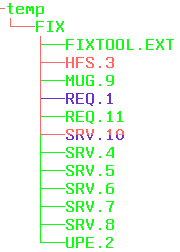Installing HPFS386 (from Warp Server Advanced) on Warp4
By Al Savage
IBM has said that, if you own Warp Server Advanced (WSA) or another product which uses the HPFS386 file system, it's OK with them for you to also install HPFS386 on any other Warp system you have.
First Steps
To install HPFS386 on a Warp4 (non-LanServer) box, you must have access to a WSA box that has the optional HPFS386 file system installed, for these files.
On the W4 box, create:
x:\IBM386FS
Copy the contents of the WSA box's x:\IBM386FS dir to the W4 box.
On the W4 box, if you do not have File & Print Services ("Peer Networking") installed, create:
x:\IBMLAN
On the W4 box, create:
x:\IBMLAN\NETPROG
Copy these files from WSA box's x:\IBMLAN\NETPROG dir to the W4 box:
CACHE386.exe CACH.msg CAC.msg
Edit CONFIG.sys
Make the following changed to CONFIG.SYS
Place a 'REM' in front of IFS=E:\OS2\HPFS.IFS Add IFS=x:\IBM386FS\HPFS386.IFS /A:* /AU Add x:\IBMLAN\NETPROG; to LIBPATH Add x:\IBMLAN\NETPROG; to DPATH Add x:\IBMLAN\NETPROG; to HELP Add RUN=x:\ibmlan\netprog\cache386.exe
This last is absolutely required if you have Peer Networking installed. (Reference: [1])
If you do not add this line to your CONFIG.SYS, you will get the following error whenever you start the File and Print server:
Net 3091: the CACHE386.exe is not running, The server cannot be started.
You can start CACHE386.EXE manually from a command prompt. However, it is recommended that you edit the CONFIG.SYS and add the above statement.
Edit x:\IBM386FS\HPFS386.ini:
Edit "lanroot = x:\IBMLAN" to match your install drive.
Edit "cachesize = 32000" (or whatever the number is) to match your desires.
There are a bunch of other parameters you can reset as well. Don't, unless you think you know what you're doing.
Update HPFS386 files
Update HPFS386 files with WSA update IP08532 (from IBM)
Running the CSF on this update won't work, because it will only update half the files. Something about it not being a "real" LS box, though CSF won't complain. It'll pretend to update HPFS386, but fails to update CACHE386.exe, so it's better to apply the update file-by-file.
Use the Fastkick/DSKXTRCT method to unpack disks 4, 5, and 6 from:
IP08532.4dk IP08532.5dk IP08532.6dk
This will create a directory structure like this:
Unpack these files, from directories marked in red (using UNPACK.exe, in Fastkick package, or UNPACK2.exe from OS/2):
FIX\HFS.3\BOOTSH.EX_ FIX\HFS.3\HPFS386.IF_ FIX\SRV.10\HPFS386.DL_ FIX\SRV.10\CACHE386.EX_
Move BOOTSH.exe & HPFS386.ifs to x:\ibm386fs
Move HPFS386.dll to x:\os2\dll (this file may not be needed, but this has not been tested)
Move CACHE386.exe to x:\ibmlan\netprog
If you are running HPFS386 at this time, you may have to boot without loading CACHE386.exe to replace the old copy. If you are using a process killer (or have "SET SCKILLFEATUREENABLED=ON" in your CONFIG.SYS) you can kill the running CACHE386.exe and then copy over it.
If you will be using Peer and ACLs to control access to resources available to other clients accessing your box running HPFS386, and you think that you may ever want to convert back to HPFS (say, to use disk partioning software to move or change a partition -- Partition Magic v5.0 utterly fails to resize an HPFS386 partition, giving an Error 1027), the you will also need the ACL utilities.
Unpack these files, from directories marked in blue (using UNPACK.exe, in Fastkick package, or UNPACK2.exe from OS/2):
FIX\REQ.1\BACKACC.EX_ FIX\REQ.1\RESTACC.EX_ FIX\SRV.10\PREPACL.EX_
Reboot!
Create HPFS386 Boot Diskettes
Create Warp4 Boot diskettes normally, or copy the installation diskettes and update them as necessary for modern, large HDDs. Note that in order to get updated kernel files on the diskette, you'll have to first copy these kernel files to diskette 0:
OS2BOOT OS2KRNL OS2LDR
and then rename OS2KRNL to OS2KRNLI.
On Disk 1 (ie the second diskette), edit CONFIG.sys:
Add "A:\;" to the beginning of the "PATH=", "LIBPATH=", and "DPATH=" lines.
Modify the line
ifs=hpfs.ifs /c:64
to read
IFS=HPFS386.IFS /AUTOCHECK:*
Modify the line
protshell=sysinst1.exe
to read
PROTSHELL=BOOTSH.EXE CMD.EXE
On Disk 2 (ie the third diskette):
Delete these files:
HPFS.IFS MARKETNG.MSG FDISK.COM TEDIT.HLP TEDIT.EXE RMVIEW.EXE
This frees up space to add the following files.
Copy these files from x:\IBM386FS to A:\ :
Copy these files from x:\IBM386FS to A:\ :
BOOTSH.EXE BSH.MSG BSHH.MSG HFS.MSG HFSH.MSG HPFS386.IFS IBMLN386.DAT
Create directory A:\IBM386FS
Copy x:\IBM386FS\HPFS386.ini (on HDD) to A:\IBM386FS
Copy x:\IBM386FS\HPFS386.ini to A:\IBM386FS
Edit A:\IBM386FS\HPFS386.ini and make the cache size reasonable for your system.
Create a Disk 3 (ie a fourth diskette) for utilities, and copy these files to it (ideally, from a FP15+ HDD installation):
TEDIT.HLP TEDIT.EXE FDISK.COM CHKDSK.COM CHKDSK32.DLL NLS.DLL UHPFS.DLL VIOCALLS.DLL ZIP.EXE UNZIP.EXE UNZIP32.DLL SHPIINST.DLL
Done! Use Disk 3 if you need to run CHKDSK or FORMAT.
Pre-fabricated HPFS386 Boot Diskettes
If you're the lazy sort (as am I), you can grab these pre-made and somewhat updated HPFS386 boot diskettes.
- Disk0 (which is the same as a "plain" HPFS boot diskette)
- Disk1
- Disk2
- Disk3 (utilities which were moved from Disk2)
Revision History:
14Jan2012
- Fixed URLs to HPFS386 diskette images. I wonder how long those have been bad?
05-Dec-01
- Added Pre-fab'd boot diskette links.
02-Sep-01
- Added "PREPACL" notes.
- Added notes about updating the diskette kernel files.
